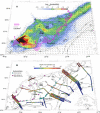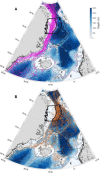A continuous pathway for fresh water along the East Greenland shelf
- PMID: 33087349
- PMCID: PMC7577721
- DOI: 10.1126/sciadv.abc4254
A continuous pathway for fresh water along the East Greenland shelf
Abstract
Export from the Arctic and meltwater from the Greenland Ice Sheet together form a southward-flowing coastal current along the East Greenland shelf. This current transports enough fresh water to substantially alter the large-scale circulation of the North Atlantic, yet the coastal current's origin and fate are poorly known due to our lack of knowledge concerning its north-south connectivity. Here, we demonstrate how the current negotiates the complex topography of Denmark Strait using in situ data and output from an ocean circulation model. We determine that the coastal current north of the strait supplies half of the transport to the coastal current south of the strait, while the other half is sourced from offshore via the shelfbreak jet, with little input from the Greenland Ice Sheet. These results indicate that there is a continuous pathway for Arctic-sourced fresh water along the entire East Greenland shelf from Fram Strait to Cape Farewell.
Copyright © 2020 The Authors, some rights reserved; exclusive licensee American Association for the Advancement of Science. No claim to original U.S. Government Works. Distributed under a Creative Commons Attribution NonCommercial License 4.0 (CC BY-NC).
Figures





References
-
- Lin P., Pickart R. S., Torres D. J., Pacini A., Evolution of the freshwater coastal current at the southern tip of Greenland. J. Phys. Oceanogr. 48, 2127–2140 (2018).
-
- Le Bras I. A. A., Straneo F., Holte J., Holliday N. P., Seasonality of freshwater in the East Greenland current system from 2014 to 2016. J. Geophys. Res. Ocean. 123, 8828–8848 (2018).
-
- Straneo F., Heimbach P., North Atlantic warming and the retreat of Greenland’s outlet glaciers. Nature 504, 36–43 (2013). - PubMed
-
- Trusel L. D., Das S. B., Osman M. B., Evans M. J., Smith B. E., Fettweis X., McConnell J. R., Noël B. P. Y., van den Broeke M. R., Nonlinear rise in Greenland runoff in response to post-industrial Arctic warming. Nature 564, 104–108 (2018). - PubMed
-
- Rahmstorf S., Box J. E., Feulner G., Mann M. E., Robinson A., Rutherford S., Schaffernicht E. J., Exceptional twentieth-century slowdown in Atlantic Ocean overturning circulation. Nat. Clim. Chang. 5, 475–480 (2015).
LinkOut - more resources
Full Text Sources

